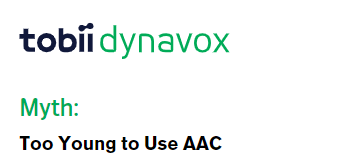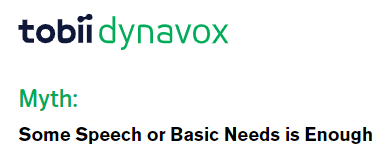MYTH! AAC will keep a person from talking.
This myth is based on the belief that using AAC means giving up on natural speech. The truth is that AAC can increase speech production.
MYTH! A child can be too young for AAC.
This myth is based on the belief that introducing AAC at an early age will impede the development of natural speech. The truth is that AAC improves natural speech and grows language skills.

MYTH! A person can be too "impaired" to use AAC.
This myth is based on the assumption that a person’s cognitive and/or physical abilities are too severely impaired. The truth is that breathing is the only prerequisite for AAC – it can be used by anyone, regardless of diagnosis or impairment level.

MYTH! AAC isn't needed If a person already has some speech.
This myth is based on the belief that having some speech is enough for basic communication. The truth is that limited speech makes it difficult for someone to express what they truly want or feel, and therefore limits their ability to participate in daily life.

MYTH! AAC is only for people who can use their hands.
This myth is based on the belief that equipment for accessing an AAC device is not medically necessary. The truth is that technology is improving all the time and people who need AAC and have difficulty using their hands have many solutions available to them, so there’s no reason to deny them access.

MYTH! AAC will fix all communication difficulties.
This myth is based on a belief that an AAC solution will enable instant communication. The truth is that implementing AAC is rarely a matter of simply putting a device down in front of someone and listening to all they have to say. AAC is a journey that takes time and persistence.



